Master Cooking Seasoning Techniques Like a Pro
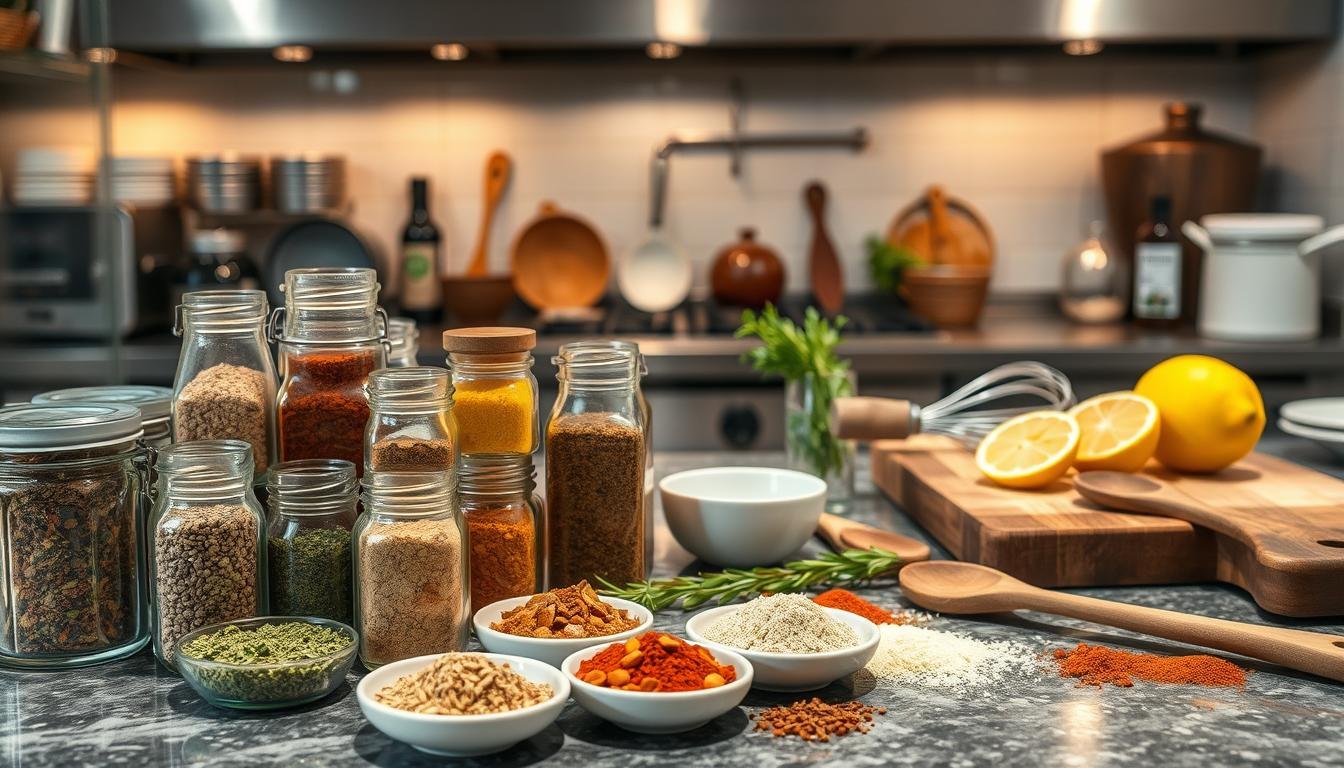
Ever wondered why some meals are so flavorful and others aren’t? It’s not just for the pros. Home cooks can master seasoning, too!
Imagine making a plain steak or simple sauce taste like it’s from a gourmet restaurant. It’s all about knowing how to season. Using salt and spice blends right can turn your meals from okay to amazing.
Let’s explore the art of seasoning. It can make beef, chicken, or veggies taste way better. Seasoning is key to creating flavors that burst in every bite. It’s more than just flavor; it’s about making your food unforgettable.
Key Takeaways
- Seasoning enhances the natural flavors of meat, with different profiles for beef, chicken, and more.
- Salt is vital for drawing out and retaining moisture in meats.
- Brining and quick salting vary depending on meat cuts size and type.
- Fresh herbs like rosemary and thyme add distinct aromas.
- Acidic elements like lemon juice can tenderize and brighten flavors.
- Avoid under-seasoning—meat can handle substantial seasoning.
- Finish dishes with a sprinkling of herbed salt for enhanced flavor.
Understanding the Basics of Seasoning
Learning how to season can make your cooking better. It doesn’t matter if you’re new or skilled in the kitchen. Knowing how to use seasoning can make your food taste amazing.
What is Seasoning?
Seasoning is more than just adding salt and pepper. It’s about making food taste better with different flavors. You use salt to enhance flavors, herbs for aroma, and spices for a special zing. Did you know thyme works in many dishes? It’s great in vegetables, meats, and soups. Knowing how to use each seasoning can make your food exciting.
Importance of Seasoning in Cooking
Good seasoning turns plain food into something extraordinary. Salt doesn’t just add flavor. It balances sweet and reduces bitter tastes, enhancing umami. Just a little can change a dish completely. Think of how dull veggies become tasty with the right seasoning. Mastering these tips can make your cooking stand out.
Types of Cooking Seasonings
Exploring seasonings is exciting! Herbs have earthy tones. In contrast, spices offer a bold punch. Each one adds new flavors to your dishes. Want to nail a classic recipe? Or mix herbs and spices in new ways? Knowing about these seasonings and salt types will help. Let’s explore herbs, spices, and salts!
Herbs vs. Spices
It’s key to know the difference between herbs and spices. Herbs, like basil and cilantro, come from leaves. Spices, though, come from seeds, roots, or bark. Think cinnamon or cumin. This difference changes how we use them. For example, fresh herbs add a vivid flavor and are often added last. Spices are usually dried and can be toasted to boost their flavors by up to 30%!
Salt Variations
Salt is key in cooking and comes in many forms. Each salt type, like table salt or Himalayan pink salt, adds a unique touch. Table salt is processed and has anti-caking agents. Sea salt keeps its natural minerals. Himalayan pink salt is known for its color and earthy taste. And kosher salt is great for seasoning due to its flaky texture. Here’s a quick guide to different salts:
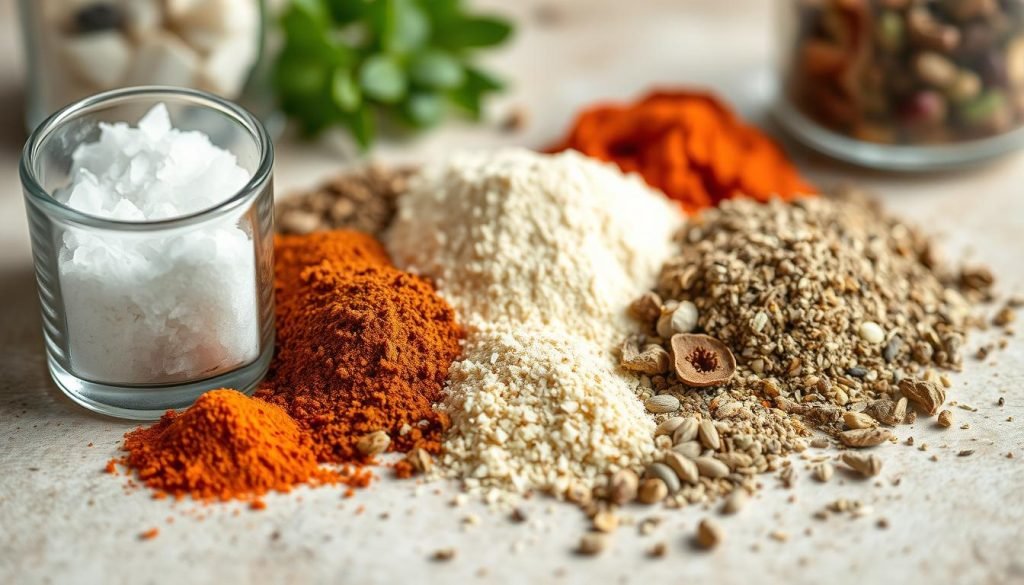
| Type of Salt | Texture | Best Uses |
|---|---|---|
| Table Salt | Fine | All-Purpose Cooking |
| Sea Salt | Varied Crystals | Finishing Dishes |
| Himalayan Pink Salt | Fine to Coarse | Seasoning Grilled Meats |
| Kosher Salt | Flaky | Brining, General Seasoning |
Understanding these seasoning differences makes you a better cook. Why not try new herb and spice mixes? Or toast your spices? Use these tips to make your dishes pop!
The Role of Salt in Seasoning
Salt does more than just flavor food. It unlocks the true taste of ingredients. It enhances food’s natural flavor instead of making it salty. Getting seasoning right can be hard for many cooks. Let’s explore the different salts and how they boost flavor!
Different Types of Salt
- Kosher Salt: It’s loved for its clean taste and bigger flakes, which helps avoid using too much. Yet, it’s not best for seasoning food that’s already cooked.
- Sea Salt: Serious cooks love sea salt for its complex flavors from natural minerals.
- Iodized Salt: Experts often avoid it because of its taste from added stuff, but many still use it at home.
Each salt type has its own role. Knowing them can really make your food better.
How to Use Salt Effectively
Salting food is more than just a sprinkle. For real taste boost, add salt bit by bit, tasting as you go. It’s hard to fix if you add too much.
- Season early: In long-cooking dishes like soups, add salt early. It brings out flavor as the dish cooks down.
- Layer flavors: Salt each part of layered dishes (like casseroles) on its own. This ensures everything tastes great together.
- Enhance browning: Salt pulls out moisture, helping ingredients brown better during cooking.
Also, remember some stuff like stocks and cheese already have salt. This can change how much more salt your dish needs. Plus, seafood naturally has a lot of salt, so be careful not to add too much.
Smart seasoning can really lift your cooking. So, let’s start seasoning like experts!
Exploring Fresh vs. Dried Herbs
Knowing when to use fresh or dried herbs is key in cooking. Fresh herbs add a bright taste, great for salads or uncooked dishes. Dried herbs, though, give a strong flavor suited for cooking slowly like in stews. Let’s learn when to pick fresh or dried herbs.

Best Practices for Using Fresh Herbs
Fresh herbs bring quick flavors to dishes. They’re great in salads, salsas, and light-cooked meals. Think of using parsley, tarragon, and chives fresh for their taste. But, cooking them too long can make them lose flavor.
Here’s how to use them right:
- Put herbs like cilantro, basil, and mint in cold dishes.
- Add fresh herbs late in cooking for a flavor boost.
- Keep them in a damp towel and plastic bag to last longer.
When to Choose Dried Herbs
Dried herbs are best for dishes that cook a while. They need time to spread their flavor. They last long and are strong, so they’re great for seasoning. Here’s when dried herbs work better:
- Use them in meals cooking over 45 minutes, like stews.
- Remember: use a teaspoon dried for each tablespoon fresh.
- Change dried herbs yearly for the best taste.
- Oregano works well in dishes that cook for a long time.
Choosing right between fresh or dried herbs changes your cooking. It can make your meals vibrant or rich in taste. Keep following our tips for more on seasoning!
Layering Flavors Through Seasoning
Wondering how to make dishes that everyone loves? The trick lies in layering flavors skillfully. Dive into different seasoning methods to make your meals stand out.
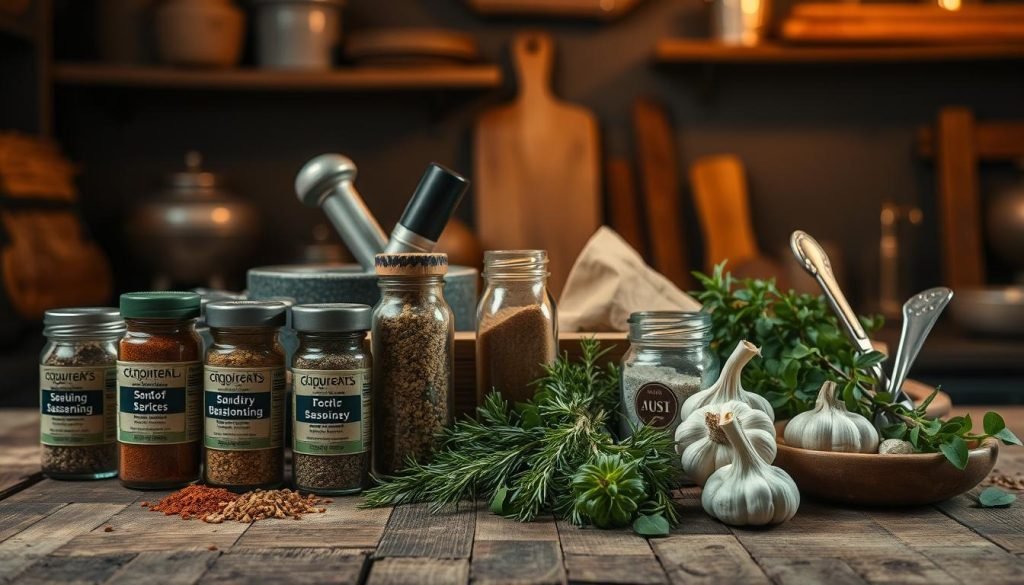
Techniques for Layering Seasonings
When you layer seasonings, you add flavors step by step as you cook. This makes a huge difference. Let’s explore key methods:
- Sautéing Aromatics: Start by sautéing onions, garlic, and celery. This base step is key in many cuisines around the world.
- Early Addition of Herbs and Spices: Add herbs like thyme and spices such as cumin early. This helps flavors merge and deepen.
- Tasting and Adjusting: Taste and adjust as you go. Cooking is more a journey than a set of steps!
- Pressure Cooking: A pressure cooker makes cooking faster and flavors richer, perfect for stews.
- Timing is Everything: Add salt later, not early, to bring out flavors. Add root veggies first, then delicate herbs.
Common Flavor Combinations
Combining the right ingredients can take a dish from good to great. Check out these classic mixes:
| Dish | Key Elements |
|---|---|
| Caprese Salad | Tomatoes (acid + sugar), Mozzarella (fat), Olive Oil (fat), Salt (salt) |
| Broccoli Sautéed with Garlic and Lemon | Garlic and Lemon (acid), Butter or Olive Oil (fat), Salt (salt) |
| Southern Vietnamese Pho | Meat, Broth (fat), Lime (acid), Chili Peppers (spice), Bean Sprouts (crunch) |
Mastering seasoning methods and flavor enhancement will take your dishes to the next level. Bon appétit!
The Science Behind Seasoning
Learning about seasoning hacks can change your cooking for the better. It’s about mixing flavors like sweet and sour to make your food pop. Getting these right opens up new ways to cook. There’s a lot more to taste than just this, though.
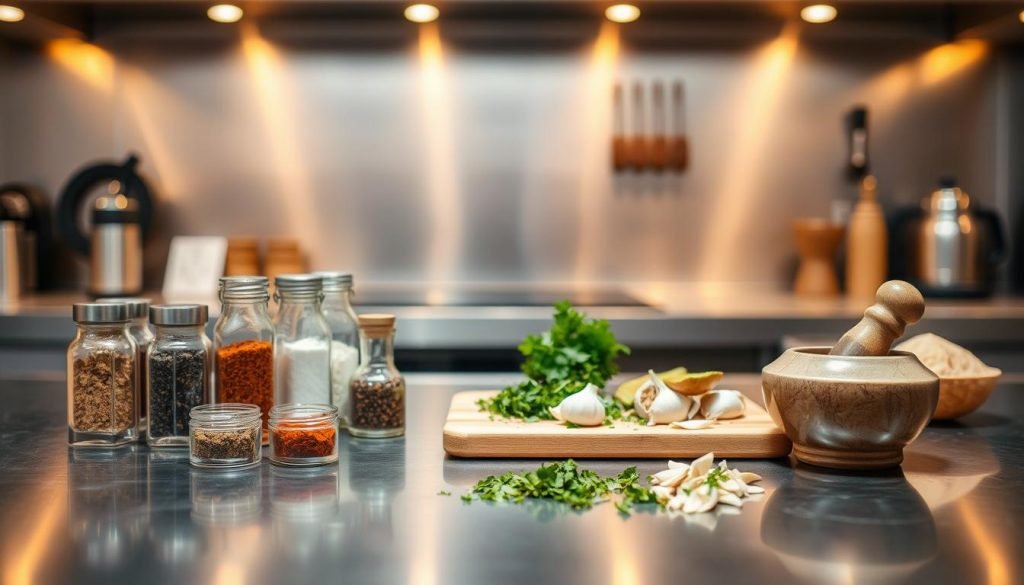
Understanding Flavor Profiles
Most of what we taste actually comes from smelling. That’s why foods can taste so complex! But balancing flavors is easy. Just recognize the main tastes in what you’re cooking. See how they work together. For example, mixing sweet and savory makes meat taste better. The Maillard Reaction creates a delicious crust on roast beef. It shows how cool food science is!
The Chemistry of Taste
Seasoning isn’t just about salt and pepper. It’s knowing how ingredients mix on a tiny level. For instance, oils rich in omega-3s, like flaxseed, are perfect for seasoning pans. They create a tough, slick surface great for cooking. This knowledge can really improve your cooking.
| Oils | Properties |
|---|---|
| Flaxseed Oil | Contains 57% ALA, ideal for cast iron seasoning |
| Avocado Oil | Highest smoke point at 520°F |
| Bacon Fat | Lower in omega-3s compared to natural diet lard |
Cooking is both science and art. Using these seasoning hacks enhances flavor and texture. Happy cooking! May your food always taste great!
Cultural Influences on Seasoning Choices
Have you thought about how different cultures make their dishes taste so good? They use seasonings in unique ways. This shows us new combinations of herbs and spices to try in our cooking.
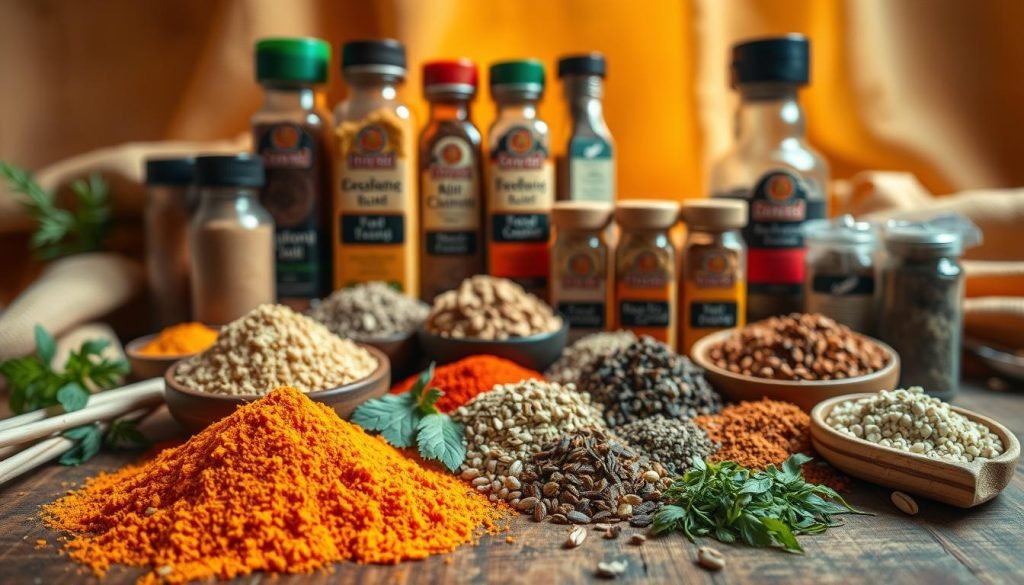
Regional Flavor Profiles in America
America’s flavors come from many places because of its people from all over the world. In the South, spices like cayenne mix with cozy herbs like thyme. In New England, it’s more about sage and rosemary, thanks to European tastes. The Southwest is all about chiles and cumin, making Tex-Mex dishes spicy and loved.
The Midwest has its own flavors, using dill and mustard seeds to make tasty pickles and sausages. Each place in America has its special mix of spices. They tell interesting stories and make food special.
Global Seasoning Techniques
Globally, the way people season food is eye-opening. India is famous for its use of many spices in one dish. Spices like turmeric and cardamom make dishes taste amazing and are also good for health. Ayurveda talks about these benefits, showing how flavors can make us feel better.
In Europe, dishes often have gentle herb tastes, like basil and oregano in Italy, making meals fresh and smelling great. Asian food balances different tastes like sweet, salty, and spicy. Thai dishes use lemongrass and galangal for exciting flavors.
History tells us about spices’ big impact. Spices were so valuable that they were once used as money. They’ve even been to space! Back in 1806, a huge amount of pepper was shipped to Salem, Massachusetts. This showed how much people in America started loving rich flavors.
| Region | Key Spices & Herbs | Distinctive Dishes |
|---|---|---|
| The South (USA) | Cayenne, Paprika, Thyme | Gumbo, Fried Chicken |
| New England | Sage, Rosemary | Clam Chowder, Stuffing |
| Southwest (USA) | Chiles, Cumin | Chili, Enchiladas |
| India | Turmeric, Cardamom, Black Pepper | Curry, Biryani |
| Europe | Basil, Oregano | Pasta, Pizza |
| Thailand | Lemongrass, Galangal | Tom Yum, Green Curry |
Advanced Seasoning Techniques
Want to improve your cooking? Let’s explore some advanced seasoning techniques! I recall the first time I infused oils. It changed my cooking. Imagine creating a flavor symphony. Using infused oils, vinegars, marinades, and rubs adds layers of flavor. This turns simple meals into amazing experiences.

Infusing Oils and Vinegars
Infusing oils and vinegars is magical. Imagine immersing herbs, spices, or fruits in high-quality olive oil or vinegar. The process is simple, but the results are incredible! It’s flexible too. You can choose your flavors. Want some spice? Add chili flakes to your oil!
Toasting whole spices before grinding them is a chef’s secret I learned. It boosts their scent and taste. This makes your oil or vinegar even better. It makes seasoning feel like an art.
Using Marinades and Rubs
Marinades and rubs are about timing and ingredients. Did you know kosher salt is best for meat? Its big grains stick well, enhancing flavor. Let seasoned meat sit for hours or overnight. This makes the meat juicy and tasty.
Imagine getting ready for a BBQ. You have your steaks and a great rub. One chef says to season steaks a day early. This flavors the fat well. But, some like to season just before cooking. Find what works for you.
| Technique | Key Benefits | Best Practices |
|---|---|---|
| Infusing Oils | Intensifies Flavor | Use high-quality ingredients; toast spices before infusing |
| Infusing Vinegars | Adds Tang and Depth | Experiment with herbs and fruits; let sit for at least a week |
| Marinades | Deepens Flavor, Tenderizes | Marinate for a few hours to 24 hours; balance acids and oils |
| Rubs | Forms Flavorful Crust | Use coarse salt; let meat rest after application |
These techniques let you play with flavors. It’s about experimenting and enjoying cooking! For more tips on seasoning and spices, keep learning and be creative.
Seasonal Seasoning Strategies
Changing how you season with the seasons can change your cooking game. Each season’s fresh ingredients need special seasoning tricks. This brings out their true taste. Whether it’s using fresh herbs in summer or cozy spices in fall, the right seasonings make dishes taste their best.
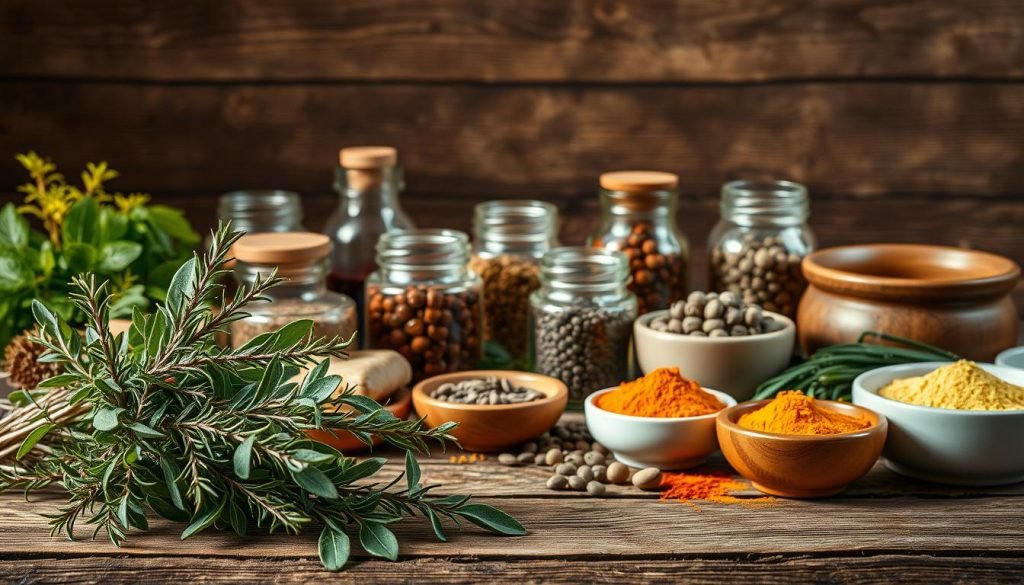
Adjusting Seasoning with Seasonal Ingredients
The taste of seasonal ingredients is unmatched. They also need special seasoning touches. For example, summer tomatoes are great with just sea salt and basil. But, winter veggies like carrots taste great with rosemary and sage. By doing this, you make every meal fit the season perfectly.
Best Seasons for Various Herbs and Spices
It’s key to know when to use certain herbs and spices. Spring is good for light herbs like chives, great in salads and fish. Summer is for strong herbs like basil, which are great with meats and pasta. In fall and winter, spices like cinnamon add cozy warmth to food. Using the right herbs or spices in the right season makes cooking always exciting and tasty.
Tips for Perfectly Seasoned Dishes
Making tasty dishes is mostly about learning some seasoning hacks. To get meals that always taste great, you need to taste and change seasonings while cooking. Let’s explore some seasoning tutorials to boost your cooking skills.
Tasting and Adjusting Seasonings
It’s important to taste your food as you make it. This helps you know if it needs more salt or lemon juice. Regular tasting helps you catch what’s missing, improving your seasoning ability. Experts say to season from a height to spread salt and pepper evenly.
Know that Morton kosher salt is saltier than Diamond Crystal. This info can prevent your meal from getting too salty. Fresh spices and whole peppercorns give your food a stronger taste. Pre-ground spices might not be as strong after nine months.
Common Mistakes to Avoid
Even good cooks make mistakes. Adding too much salt is one, but there’s a fix. Try adding liquid, dairy, or lemon juice to get the taste right. Cooking whole spices in fat brings out their best flavors. Not doing this can make your food feel flat.
Pre-ground pepper might not be as zesty because it’s often old. Also, bigger salt crystals taste stronger. Adjust how much you use based on this. Remember, MSG boosts umami but affects people differently.
Cooking is a journey, and mastering seasoning is a part of it. Use these seasoning tutorials and watch out for mistakes. You’ll enjoy making dishes that taste just right. Happy cooking!